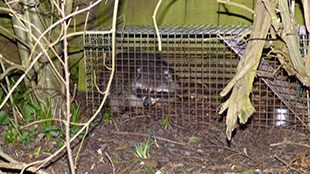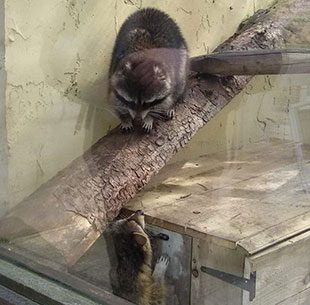One of APHA’s Mammalian Ecologists from the National Wildlife Management Centre (NWMC) talks about how she helped capture and rehome a raccoon.
My work as a Mammalian Ecologist at APHA is very varied. However this is one of the more unusual projects I have been involved in - the capture and rehoming of an escaped raccoon in Sunderland!
To give you some background, invasive non-native species are the second most significant cause of biodiversity loss worldwide and are an increasing priority globally.
Raccoon risks
At the NWMC we carry out field control and monitoring operations, focusing on invasive non-native species and assessing the impact of them. In 2013 the Centre of Ecology and Hydrology, together with several other organisations including the NWMC, identified the common raccoon (Procyon lotor) as one of the “top ten highest risk future alien invasive species in Great Britain based on likelihood of arrival, establishment and impact on native biodiversity over the next ten years.” Raccoons can be carriers of a number of diseases and parasites including rabies and the roundworm, Baylisascaris procyonis, which can be fatal in humans. They also cause damage to buildings, raid fruit crops and threaten native wildlife through competition and predation. Raccoons occasionally escape from private collections, but are not yet established in the UK and, for the reasons mentioned above, we would like to keep it that way.
Raccoon sighting
In February 2015 a raccoon was first spotted on CCTV on the campus of Sunderland University (see the YouTube video). The same, or possibly another animal, was spotted in November 2015 by a Sunderland householder in their back garden. After discussions with Defra and Natural England, we decided to investigate further.
In December 2015 I placed remote cameras (that sense heat and movement) around the area and they confirmed the presence of a raccoon. All involved decided that the raccoon should be trapped and a suitable new home for it found.
Raccoon capture
Working closely with the Sunderland householder, we placed cage traps in the garden on the 15 January 2016 and put out food such as cooked meat and molasses to encourage the animal to visit and enter the traps. By the 30 January I had evidence that the raccoon was entering the trap to take the bait, from a camera that automatically sends photos via text messages and emails.

I set the traps on the evening of the 2 February at 6pm. At 3.20am I was woken up by a text message telling me the trap had been triggered from a trap monitoring system. I was on site within an hour, ensuring that the raccoon was in the trap for as short a time as possible

I found the raccoon sitting in the trap. It appeared healthy, not overly stressed though perhaps a little perplexed! I took it to a Defra animal facility close by, where an enclosure had been prepared for it, complete with paddling pool (raccoons are very fond of water), hammock and climbing apparatus.
A visit to the vets confirmed it was male, whereupon he was promptly neutered and given a clean bill of health. He settled in well and was named Bert after the character in the children’s cartoon, The Raccoons. He became a bit of a local celebrity, attracting a number of visitors. He was fed on a wide variety of food and particularly enjoyed ‘fishing’ for dead mackerel in his paddling pool and hunting for grapes hidden around his enclosure. Raccoons are relatively intelligent mammals and good problem solvers so enrichment like this is very important for their wellbeing.
Bert rehomed

Through discussions with the local zoo inspector, a suitable home was found for him at The Jungle Zoo in Cleethorpes. The zoo already owned a raccoon and was wanting a playmate for him. We delivered Bert to his new home on the 4 April. His arrival was attended by the Sunderland householders who were very happy with the outcome. He is now in his new enclosure and has been successfully introduced to his new playmate.
The whole story was positively reported in several local and national newspapers and the outcome was welcomed by all involved. I personally really enjoyed working with a novel species and I found it very rewarding to see him happy in captivity, socialising with his own kind.
Follow APHA on Twitter and don't forget to sign up to email alerts.

Recent Comments